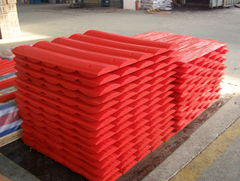Discussion about oil and chemical resistance of polyurethane
 Generally speaking, the oil resistance of
polymers refers to the general oil resistance including solvent resistance,
which is in principle adapted to the expansion equilibrium formulation
developed by Flory et al. That is to say, only expansion occurs, and only
equilibrium of expansion occurs. Chemical resistance or chemical resistance
reagents can be understood as the stability of water and inorganic drugs. It
includes not only the expansion process of polymers, but also the chemical
reaction between polymers and chemicals (usually water solutions of inorganic
drugs), which leads to the aging and cracking of polymers, and the
decomposition, dissolution and extraction of complexes.
Generally speaking, the oil resistance of
polymers refers to the general oil resistance including solvent resistance,
which is in principle adapted to the expansion equilibrium formulation
developed by Flory et al. That is to say, only expansion occurs, and only
equilibrium of expansion occurs. Chemical resistance or chemical resistance
reagents can be understood as the stability of water and inorganic drugs. It
includes not only the expansion process of polymers, but also the chemical
reaction between polymers and chemicals (usually water solutions of inorganic
drugs), which leads to the aging and cracking of polymers, and the
decomposition, dissolution and extraction of complexes.
Polyurethane elastomers exhibit excellent oil and non-polar solvent resistance, and increase with the increase of polar groups, crosslinking density and intermolecular force in macromolecules. Therefore, it is not difficult to infer that the oil resistance of polyester type is better than that of polyether type. In the polyester type, the oil resistance increases with the increase of ester group concentration. For the same soft segment, the oil resistance of polyurethane elastomer increases with the increase of rigidity and content of hard segment, that is, the higher the hardness of elastomer, the better the oil resistance.The chemical resistance of polyurethane elastomer is also good, and increases with the increase of the hardness of the elastomer.
At room temperature, in 20% acetic acid and 50% NaOH solution, poly (epsilon-caprolactone), PTMG and PPG all showed certain resistance. However, in 50% sulfuric acid and 20% nitric acid solution, the above two polyether types can not withstand the erosion of sulfuric acid and nitric acid, and only poly (epsilon-caprolactone) type shows better resistance. This is because the hydrogen on the alpha-carbon atom of the ether group is easily oxidized and cracked.










